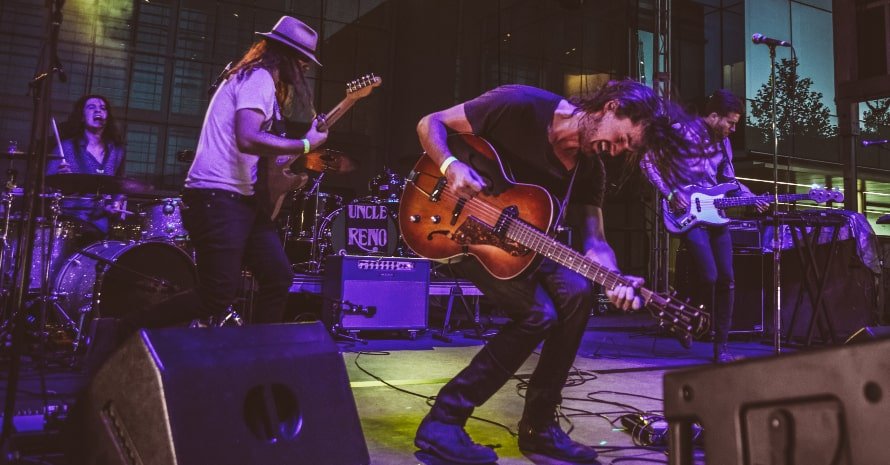How to Improvise on Guitar? The Right Way To Go About It

The ability to improvise music is not some inborn talent but a skill that can be taught – and it’s never too late to learn.
Improvise on musical instruments is the spontaneous invention of melodic, harmonic, or rhythmic material during the performance of a composed piece or section.
One of the great things about the guitar is its versatility – with just a few simple chords you can play a huge range of songs. Improvising on the guitar is a great way to do this, and it’s not as difficult as you might think.
How Does Improvisation Work in Music?
Contents
Musical improvisation is the spontaneous composition of melodic, harmonic, or rhythmic material. It is often characterized by the absence of predetermined parts, reliance on some degree of improvisation, and sometimes a loose or even nonexistent structure. Improvisation is also featured in classical music, and many other genres including folk, world music, rock, and pop.
While it is often associated with jazz music, improvisation is a skill that can be applied to any genre or style of music. Improvisation can be used to create new melodies, bass lines, chord progressions, and even entire songs. It is a valuable tool for composers, arrangers, and performers of all types of music.
The benefits of the improvisation skill
There are many benefits to improvisation in music. For one, it encourages creativity and spontaneity. It also helps musicians to develop their skills of ear training and composition. Improvisation can also be a way to overcome stage fright, as it allows performers to focus on the music rather than on the audience.
The main thing about improvisation in music
There are a few things to keep in mind when improvising in music.
- It is important to relax and let the music flow.
- Trust your instincts and go with your first idea.
- Don’t be afraid to make mistakes.
- Have fun and enjoy the moment!

Types of Improvisation
There are many types of improvisation on the guitar. Some guitarists improvise by using scales, while others improvise by using chords. Some improvise by using arpeggios.
Scales
When it comes to guitar improvisation, one of the most important things you can do is to learn how to use scales. By understanding how to use scales, you’ll be better able to create interesting and unique-sounding solos.
There are a variety of different scales that you can use for improvisation. The most commonly used scales are the major and minor scales. These two scales are the foundation for most Western music.
The major scale is made up of seven notes, while the minor scale has six notes. The minor scale is a bit more mellow sounding than the major scale.
In addition to the major and minor scales, there are also some other scales that you can use for improvisation. These include the blues scale, the pentatonic scale, and the chromatic scale.
Each of these scales has a unique sound and can be used to create different sounding solos. It’s important to experiment with all of these different scales to find the one that you’re most comfortable with.
Once you’ve chosen a scale, the next step is to learn how to use it. One of the best ways to do this is to find a backing track that’s in the same key as the scale you’re using.
Once you’ve found a backing track, start improvising over it using the scale. Experiment with different notes and see how they sound. You may also want to try playing the scale in different positions on the fretboard.

Chords
In guitar improvisation, chords are often used as the basis for creating new melodies. When soloing, a guitarist will often create new melodies by stringing together a series of chords. Chords can also be used to create background textures and rhythms or to fill in gaps in a melody.
Guitarists can improvise using any type of chord, but some chords are more commonly used than others. Major and minor triads are the most common type of chords used in improvisation, but seventh chords, suspended chords, and other types of chords can also be used.
When improvising, it is important to be aware of the overall harmony of the song or piece of music. This will help the guitarist to choose appropriate chords and to create a cohesive improvisation.
It can be helpful to practice improvising over a variety of chord progressions. This will help to develop a feel for how different chords sound and how they can be combined.
There is no one correct way to improvise. Experimentation and exploration are key to finding your style.
Arpeggios
One of the most effective ways to improvise on the guitar is to use arpeggios. Arpeggios are simply the notes of a chord played one at a time, in order. For example, if you are playing a C major chord, the notes in the arpeggio would be C, E, and G.
When improvising, you can use arpeggios to create interesting melodies and solos. To do this, you’ll need to know the arpeggios for the chords you are playing. For example, if you are playing a C major chord, you would use a C major arpeggio.
There are many different ways to play arpeggios on the guitar. One popular way is to use a picking technique known as “sweeping.” To sweep pick an arpeggio, you simply pick each note in succession.

Another popular way to play arpeggios is to use a technique called “tapping.” To tap an arpeggio, you simply press your finger on the string at the desired fret and then use your other hand to pick the string.
You can also use a combination of picking and tapping to play arpeggios. This is a great way to create complex solos and melodies.
Arpeggios are a great tool for improvising on the guitar. By using sweeping and tapping techniques, you can create interesting solos and melodies.
How Do Improve Improvisation?
The more you improvise, the more you’ll be able to isolate the licks you like, and the more you’ll be able to integrate them into your improvising.
Here are some tips for isolating licks:
1. Listen to a lot of guitar players.
This may seem obvious, but it’s important. The more guitar players you listen to, the more licks you’ll be exposed to. You can’t isolate what you don’t know exists.
2. When you hear a lick you like, figure it out.
Many people get stuck on this. They hear a lick they like but they don’t bother to figure it out. Then they just keep listening to guitar players and hoping they’ll hear the lick again.
The best way to figure out a lick is to slow it down. You can use a program like Guitar Pro or TuxGuitar to do this. Or you can use your ear.
3. Repeat the lick.
Once you’ve figured out the lick, repeat it over and over again. The more you repeat it, the more it will become ingrained in your muscle memory.
4. Experiment with the lick.
After you’ve repeated the lick enough times that you can play it without thinking about it, start to experiment with it. Try changing the order of the notes, or changing the rhythms.
5. Add the lick to your improvisations.
Once you’ve experimented with the lick and feel comfortable with it, start using it in your guitar improvisations. Remember, using licks and ideas from your favorite players is the best way to learn to play the guitar.
Music Improvisation Techniques
One of the most popular and popular techniques for guitar improvisation is the “ fuzz pedal.”
The fuzz pedal can help make the sound more expressive by adding more end-stage filters. This can be used to add more warmth, diversity, and life to the guitar sound. Another popular technique for guitar improvisation is the “6-fret guitar vintage” technique.
This technique is to use 6 frets on the guitar, and it can be done in any order that you want. This will make the guitar sound more overall diverse and separate from the playing style.
Lastly, another popular technique for guitar improvisation is the “solo” technique. This is to play the guitar solo. This can be done with any instrument, whether it is an acoustic or an electric one. This is a great technique to use if you want to create a more intelligible guitar sound.
FAQ
What songs can you improvise on the guitar?
If the guitarist can improvise, they can make up their solos or create new melodies over existing chord progressions. Some songs that are commonly improvised on the guitar include jazz standards, blues progressions, and classical pieces.
What are some common mistakes people make when improvising?
One common mistake people make when improvising is not staying in the moment. It’s easy to get caught up in thinking about what you’re going to play next or what you’ve already played, but it’s important to stay focused on the present. Other mistakes include not listening to your fellow musicians.
What are some things to avoid when improvising?
Some things to avoid when improvising is overthinking and overplaying. Overthinking can lead to missed opportunities and lost ideas. Overplaying can make your improvisation sound forced and unnatural.
Conclusion
To learn guitar improvisation, you must be patient, stay dedicated, be willing to practice regularly, and be open to learning new techniques that can help you to improve.
To become a better improviser, you must also be willing to listen to other guitarists and learn from them. Pay attention to the way they play and the techniques they use. You can learn a lot by watching and listening to other guitarists.

